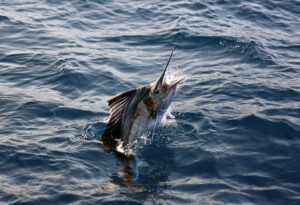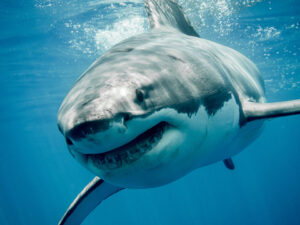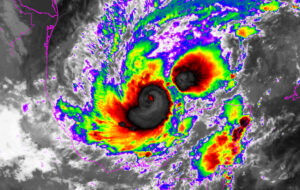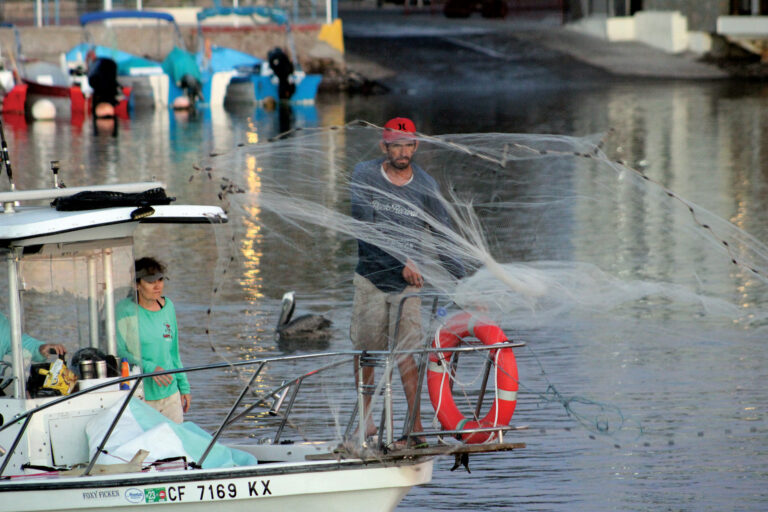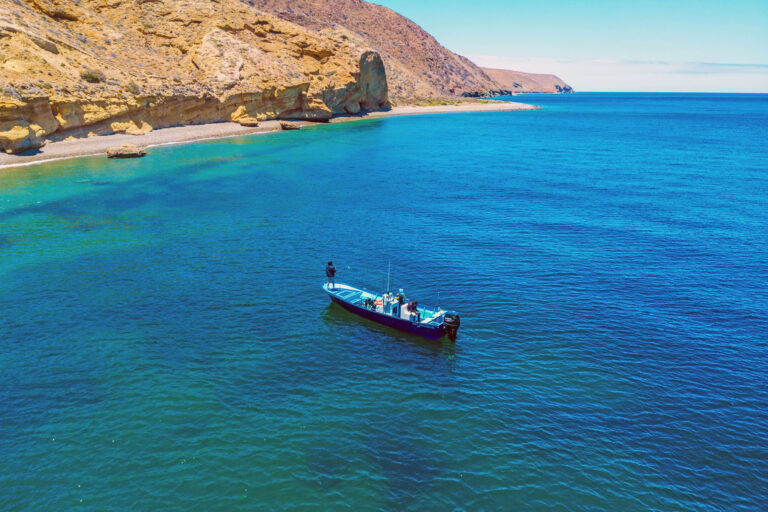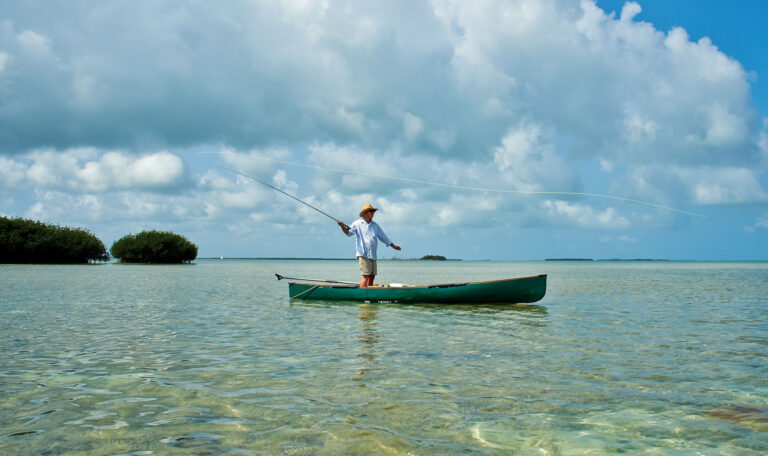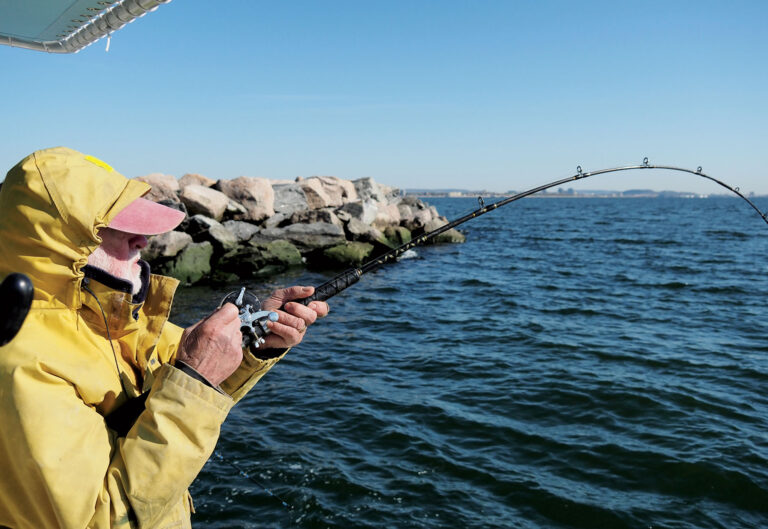 Red drum enthusiasts spend the wintergetting ready for the spring season.
Red drum enthusiasts spend the wintergetting ready for the spring season.By Ric Burnley
Drum Roll
Scores of “drumheads” in the mid-Atlantic take to boats and kayaks, beaches and piers to hunt trophy red drum
Two hours before dawn, the end of Avalon Pier is a murder scene. Yellow light buzzing from a halogen lamp falls on corpses slumped over the benches, sprawled in camp chairs and curled up on the wood-plank deck. It’s hour 30 of a 36-hour marathon red drum tournament, and these bodies are dead tired.
The scream of a line-out alarm cuts through the whistling wind. Bodies jump to life and scramble to a row of 12-foot rods leaning against the pier rail. A big redhead grabs his rod, thumbs the drag and runs backward, wildly jerking the rod tip to set the hook. When the long rod bends like a tree in the wind, the living dead burst into cheers.
Young Jake Worthington is hooked up again. This is his fourth big drum in the tournament, putting the 18-year-old ahead of his peers.
A few hours later, tournament director Jimmy Hillsman hands Worthington a new rod and reel for his victory, but the real prize is paid in back slaps and arm shots from his buddies. For anglers chasing big red drum, it’s not just about the fish. It’s about family.

Success Story
Worthington’s victory in the North Carolina surf is the result of events that occurred before he was born. Thanks to smart conservation and angler participation, red drum are the best thing going for Mid-Atlantic inshore anglers.
No one appreciates this story more than Ken Neill. He’s chased big reds for years and, as an associate commissioner with the Virginia Marine Resources Commission who is active in fisheries conservation and science, has worked to protect these fish. “Red drum fishing is part of the history and culture of Virginia and North Carolina,” Neill says. Besides serving as an important food source since pre-Columbian times, red drum became a gamefish for turn-of-the-century tourists visiting the coast.
By 1984, commercial and recreational pressure on the fish was at an all-time high. In 2002 the Atlantic States Marine Fisheries Commission prohibited the harvest of red drum over 27 inches. “The result has been a boon,” Neill says.
By 2013 the Virginia Saltwater Fishing Tournament had awarded almost 1,000 trophy citations for drum over 46 inches — the highest in the tournament’s history. For inshore anglers, red drum offer a ray of hope as dark clouds hang over other fisheries. “Striper fishing has been terrible,” Neill admits. “Even flounder and other species are down, so big red drum are the best bet for trophy hunters.”
With so much attention focused on big drum, everyone with a fishing rod and a boat spends the winter biting his nails, waiting for spring.
On a windy evening in early May, Neill and I take advantage of this bounty. The sun is a giant orange ball hanging low in the western sky by the time I anchor my 20-foot center console a few hundred yards from Neill, who’s in a 24-foot sportfish called Special Kate. We join a fleet of a dozen boats lining the edge of a shallow shoal at the mouth of Chesapeake Bay. Like Neill and me, most of these guys are looking forward to a long night of drum fishing after a long day at work.
With the current rushing past and the wind kicking up a stiff chop, my crew and I set out six rods with baits spread from deep to shallow. Then we wait.
I call Neill on the VHF radio. He has reports of fish in the area from the night before. “It should happen any time,” he says. Before he releases the button on his handset, I can hear the zing of a line-out alarm behind him. I squint through the purple light to watch silhouettes bounce around the cockpit of Special Kate. Then the net comes out. Followed by high-fives and camera flashes.
While I’m watching the action, one of our rods dips heavily and dumps line. My buddy grabs the rod and fights the kicking fish and bucking boat, trying to stay on his feet. Red drum are a strong-fighting inshore fish, and this one pulls all the tricks: runs like a bulldog, charges like a Toro Bravo, shakes its angry head and refuses to quit until it’s beat. With the 4-foot-long fish thrashing boatside, I scoop it up with a huge landing net and swing it aboard. We don’t have time to admire the catch; another rod is under pressure. I unhook the drum, lower it over the side and hold it in the water until it kicks free. The sun has set, and the fishing is heating up. I look across the darkness to see camera flashes on almost every boat in the fleet.
 Kayak anglers benefited greatly from the resurgence of the red drum fishery in the Mid-Atlantic.
Kayak anglers benefited greatly from the resurgence of the red drum fishery in the Mid-Atlantic.Paddle for Reds
No one has benefited from the red resurgence more than kayak anglers. During the past 10 years, kayak fishing and red drum fishing have exploded in unison.
When the first fishing kayaks hit the market, I set out to catch big drum on the deadly shoals at the mouth of Smith Island Inlet on Virginia’s Eastern Shore. After fishing the area in a boat, I knew I would face breaking waves, swift current, open water and relentless wind. The biggest problem: finding someone to go with me. Then I met a scraggly metalhead who had paddled from Jacksonville, Florida, to Norfolk, Virginia, proving he was crazy enough to try and tough enough to succeed.
On the first nice day in the spring, Kevin Whitley and I paddled miles out to the shoals. We anchored along the edge of the breakers and cast our baits into the shallows. Long story short, we each landed a yearling drum and discovered a kayak fishery that hundreds of anglers enjoy today.
Whitley was hooked on kayak fishing, and it wasn’t long before people started calling him “Kayak Kevin.” More recently, his passion for catching red drum in the kayak earned him the nickname “Drum Jesus.”
On a recent fall afternoon, Whitley and I paddled out to the Chesapeake Bay Bridge Tunnel to target big reds. A half-dozen disciples of Drum Jesus were already bobbing in the pilings. When I needled Whitley that his social media coverage was responsible for the crowd, he grinned and waved me off, saying, “It’s better to have them educated than doing dumb shit.” In addition to a steady stream of hero shots, Whitley posts videos on the proper techniques for catching and landing the fish. “There’s enough drum for everyone,” he says, “as long as everyone fishes responsibly.”
One of the biggest threats facing big red drum comes from poor catch-and-release practices. Red drum are slow to grow. After reaching 20 inches in three years, growth slows; these 50-pounders could be 30 or 40 years old.
It isn’t long before it’s my turn. As I bounce a 3-ounce jig next to a piling, a big fish slams my lure. Helpless against the pull, I let the fish drag me through the bridge and into the pilings. I work the reel to stay over the drum, but it darts between two pilings, and I have to flip my bail and let the fish take line while I maneuver the kayak to follow. Finally the drum pulls me into open water, but the fish won’t come up. Whitley is paddling behind me and snapping photos. “Come on,” he prods, “what’s taking so long?” He’s half joking and half concerned for the fish’s well-being. When the red finally surfaces, Whitley gasps. “Ha, ha, ha,” he chuckles, “I see the holdup.” The redfish is more than 50 inches long with a girth bigger than my own; we estimate it weighs more than 60 pounds.
Surf Drum

No one has sacrificed more for red drum than the surf-fishing community. From the dawn of sport fishing, anglers have enjoyed pulling big reds from the shore break. By the 1990s, hordes of anglers had descended on the beaches of North Carolina and Virginia to target big reds. Hot spots such as Cape Point on Hatteras and South Point at Ocracoke Island attracted hundreds of anglers looking to get their feet wet in big-game fishing. The off-season fishery supported these tourist towns through fall and spring.
The crowds that gathered at these spots turned into a community. We attended one another’s weddings and watched our kids grow up covered in sand and sunburn. Surf fishing for red drum offered the rare opportunity to fish shoulder to shoulder with 50 of your closest friends. To get in the game, you only needed a rod and reel, simple rigs and a handful of bait. To get good at the game, you needed an eye for detail, a bomber cast, the freshest bait, a network of drum buddies and a driving passion for drum fishing. Some guys are Tiger Woods. The rest are Happy Gilmore.
Then it all came to an end.
In 2007 the Audubon Society and Defenders of Wildlife brought a lawsuit against the National Park Service to regulate beach access to protect an endangered shorebird. Anglers, island residents and others fought to prevent the move, but in the end we lost the battle, the war and open access to the beaches.
Today these famous drum beaches are regulated by closings, passes, rules and signs. The community disintegrated. Some of the old crowd continue to fish Hatteras and Ocracoke, hiking miles through closed areas and suffering the rules. Others moved to lesser-known surf spots. Most drifted off to other fisheries. It takes an event like Billy Sydnor’s Memorial Drum Tournament to bring them together.
Sydnor was a keystone of the drum community. He grew up drum fishing Virginia’s Eastern Shore, then moved to the Florida Keys to guide the flats. After retiring from the poling platform, Sydnor moved to the Outer Banks and returned to his first love. “I first met Billy on the pier,” says tournament director Jimmy Hillsman. “He would invite the younger guys to his house and share photos of world records he had caught in the Keys.”
Sydnor took a job working the register at TW’s Bait and Tackle, where he shared his knowledge and enthusiasm with anyone who asked. In fact, I interviewed Sydnor 15 years ago for my first big-time drum story. He didn’t hold anything back.
When Sydnor died of cancer last summer, the drum community came together to raise money for his widow. “I didn’t ask for a single prize,” Hillsman says. “People just came out of the woodwork offering to help.” As word spread, more than 100 anglers signed up to fish 36 hours straight from one of three Outer Banks piers.
On the end of Avalon, I reunite with drumheads I haven’t seen since the glory days. We catch up on old times and watch a new generation of drum anglers take the planks.
One of those kids, Jake Worthington, is leading the tournament for biggest and most fish. His good fortune isn’t luck. Worthington has worked hard, procuring the best bait, perfecting his cast in the off-season and spending nearly every day (and many nights) on the pier.
Later he tells me that targeting big drum allows him to fish in any weather. “When the wind is blowing 20 and the waves are 4 to 5, boat guys are sitting home,” he says with a laugh. “That’s the perfect time to catch drum!”
But it’s the people who keep him coming back. “I spend a lot of time with these guys,” he says. “They’re like family.”
As he accepts the prize, his buddies chant “Avalon! Avalon! Avalon!” The anglers who fished the other piers cringe. Looking closely, I swear Worthington’s feet are floating a few inches off the ground.




